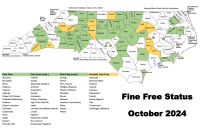Oh, dear – disease hits N.C. deer
Deer hunters may encounter sick or diseased deer afflicted with hemorrhagic disease this hunting season, according to the N.C. Wildlife Commission.
Two closely related viruses — epizootic hemorrhagic disease virus and bluetongue virus — cause hemorrhagic disease. Both are spread by biting flies, called midges.
The commission is asking hunters to report sightings of the disease, which has no human-health implications but is one of the most significant infectious diseases of white-tailed deer in North Carolina.
Symptoms of hemorrhagic disease in deer vary widely. Some diseased animals will exhibit no symptoms. Some may appear bloated, very thin and weak, while others suffering from the disease for longer duration may drastically lose weight. They also may have foot, mouth and internal lesions. High fever associated with the disease can make deer thirsty, so dead and dying deer are often found near water. Hunters may observe cracked or sloughing hooves on harvested deer, which is another classic symptom of the disease.
Outbreaks of this deer disease are seen almost every year somewhere within the state and across the Southeast. In years with severe hemorrhagic disease outbreaks, deer mortality in some localized areas can be as high as 30 percent. However, in most instances mortality is much lower.
To report sightings of symptomatic deer, or dead and dying deer, contact the Division of Wildlife Management at 919.707.0050 or This email address is being protected from spambots. You need JavaScript enabled to view it..





